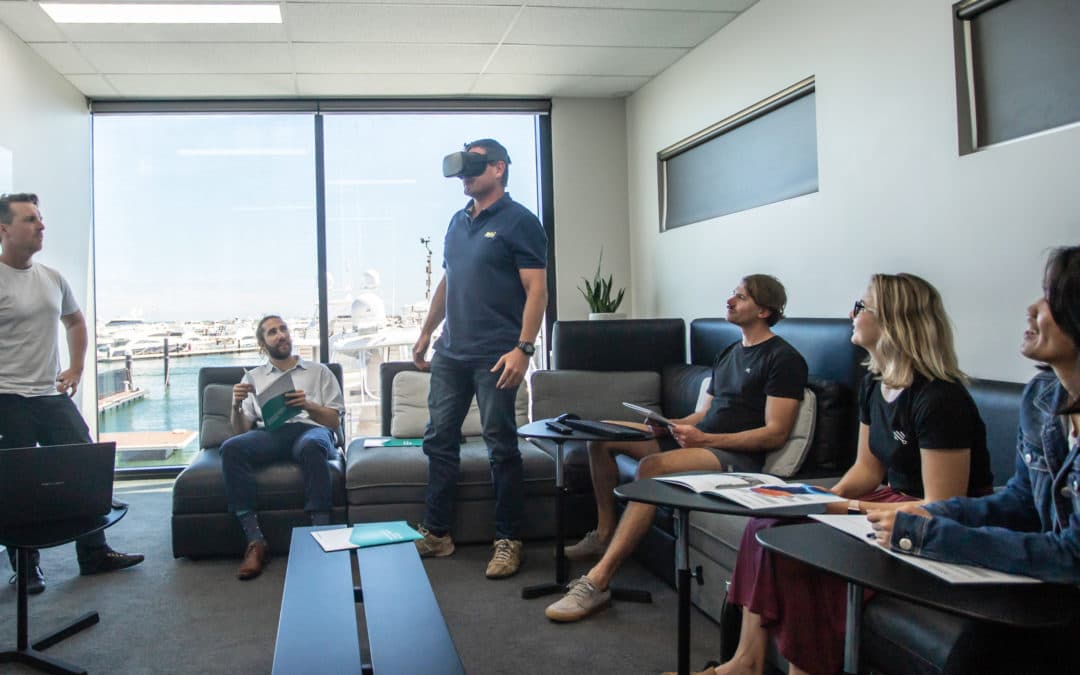Virtual reality is turning the training room on its head. Companies are ditching PowerPoints for immersive videos and swapping workbooks for headsets. But is the immersive experience right for your business? Let’s explore the pros and cons before you walk (virtually or not) down the VR training path.
First, if you’re not familiar with the fundamentals of VR training, check out our article Virtual Reality Training Explained: Benefits, Costs and More. If you‘re already across it, let’s keep moving.
Virtual reality training has produced incredible results for companies in a variety of industries all over world. This didn’t happen by accident. These successes are the result of meticulous planning and execution to ensure the VR solution was fit for purpose.
To figure out if VR training is right for you and your team, answer these five questions and discover the pros and cons along the way…
1. When is your deadline?
There are two types of people in the world: those who plan and those who don’t. VR projects are technical and require a lot of up-front planning to ensure you’re maximising for the potential of the VR medium. You can’t wing it and hope for the best.
The quickest VR solution is buying off-the-shelf/ready-to-go VR videos and application. However, the current depth of quality of off-the-shelf content is shallow. For most organisations, a custom build is the only feasible option, which can take anywhere from two to six months to complete an end-to-end production.
The key is not to rush, especially in the planning phase.
2. Who is your audience?
We can tell you’re keen on VR training, but is everyone else?
If your team is made up of millennials, they’ll probably jump at the opportunity of simulation training, whereas mature employees may be more cautious.
Be patient and reassuring with mature learners because:
a) it takes a few minutes to adjust to how immersive VR is
b) we’ve not met anyone that dislikes VR once they get used to it;
There are also a few health considerations to be aware of.
Does anyone on your team have epilepsy? Or a visual impairment? Do they experience vertigo or motion sickness? If so, you need to be wary of this and inform the production company.
A 2010 study found that people over the age of 50 are more likely to experience motion sickness than younger people. Another study found women are more likely to experience motion sickness than men (FYI, I’m a woman and have never experienced motion sickness from VR).
Chat to a VR production company (we’re happy to help) to find out more, because some of these issues come down to the production. For example, if 360 footage isn’t edited smoothly, or scenes suddenly become intense (like driving a speeding car), motion sickness can creep in.
If some learners can’t complete the training, decide how you can offer it in a different format. You could upload the 360 degree video to YouTube and let them click around to explore an environment, or for more interactive modules you can convert it to SCORM and upload it to your LMS.
3. What space do you have to conduct the training?
Once you’re confident your employees will enjoy VR, tally up how many you need to train. If you need to regularly train multiple staff, having a dedicated training room is ideal.
A large, open room with minimal furniture is perfect. Aim for a two meter diameter circle for each individual. This will safely allow them to stand up and move their arms freely without the risk of bumping contacting other participants.
Less room is needed if learners can complete the training seated, rather than standing or moving around.
If there’s not enough room on-site, you could consider conducting the training offsite. No organisation wants an employee to get injured, especially if it happens during safety training *facepalm*.
Now you’ve got your room figured out, let’s look at the other resources you need.
4. What other resources do you need?
The most important part of VR training is the headset. Remember to factor the price of headsets into your training budget when working out your total costings.
VR headsets aren’t cheap, but they’re not as expensive as you might think either – in fact, they’re actually becoming more affordable.
There are a few different types of headsets available, all of which come with controls. Our preferred headset is the Meta Quest 2, which is a wireless headset with internal storage, so it houses the content without the need of wires. To sideload (you don’t upload VR content, you sideload it) files onto the Quest 2, you’ll need a computer and a USBC cable (which comes with the device).
If your project is an interactive .apk file, you’ll need to download Side Quest, an app that allows you to sideload your project onto the headset. If it’s a 360 video, you can load the file onto the headset using the Meta software. You can also stream it directly from YouTube, but the quality may be reduced.
A third option is if you’re buying off-the-shelf content you can buy it in-headset via the Meta app store.
There are cheap headsets available, but this can affect the quality of the VR content.
Experiencing a VR project on a cheap headset is a bit like going to a burger bar and ordering a salad. You get part of the experience and feel relatively satisfied. But when you see other people getting their hands dirty with wagyu and wedges, you wish you’d fully committed.
Simply put, you won’t get the superior experience using a cheap headset, so it may not be as effective for training. It’s worth investing in at least one high-quality headset so that your learners get the experience you envisioned.
5. How will you roll it out?
Once you have your equipment sorted, think about how you’ll roll it out to your team.
We always recommend our clients have someone internal dedicated to maintaining the headsets – keeping them clean, charged and available for troubleshooting.
We usually train the client up ourselves when we hand the project over.
You also need to think about how the students will access the tech. Will they have to travel to you, or will you go to them?
A bonus of VR is that it’s portable, so you can conduct training remotely or take it wherever you go.
There are pros and cons to every type of training, including VR training, but with a bit of planning and forward thinking, you can roll out a first-class learning experience.
If you’re based in Perth, WA and want to try the tech out, get in touch and we’d be happy to help!


